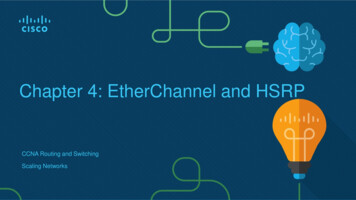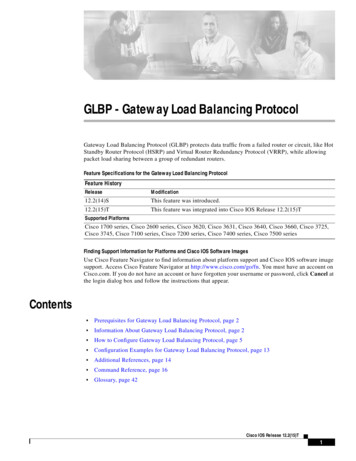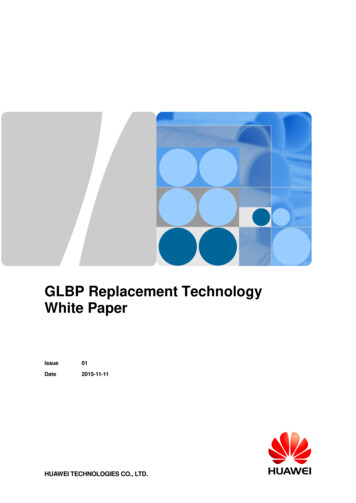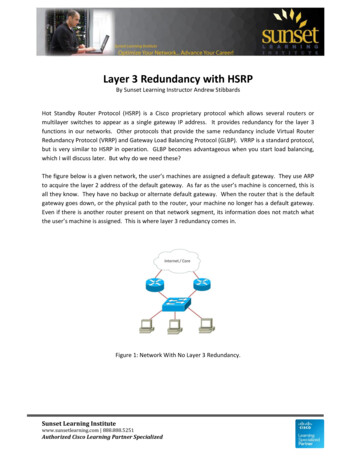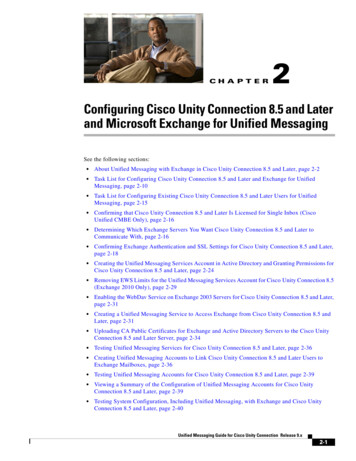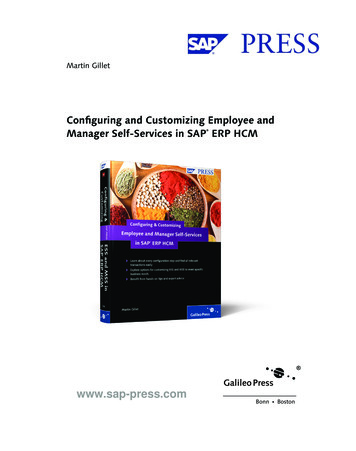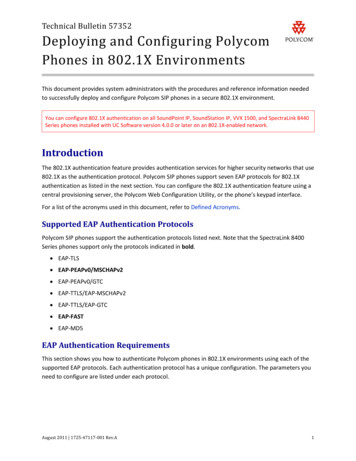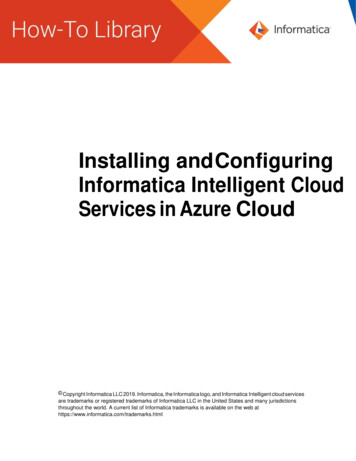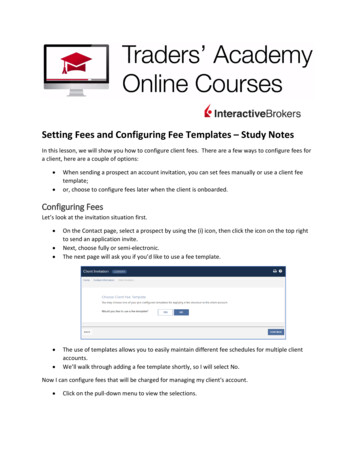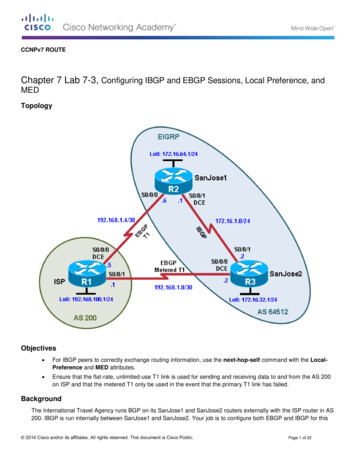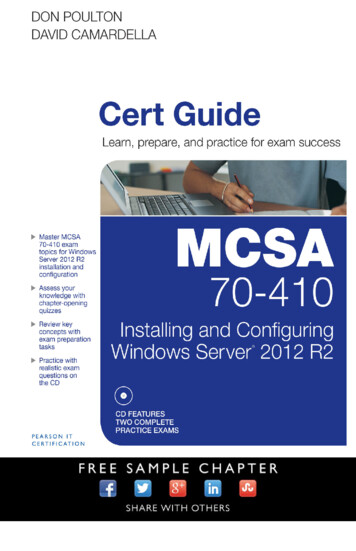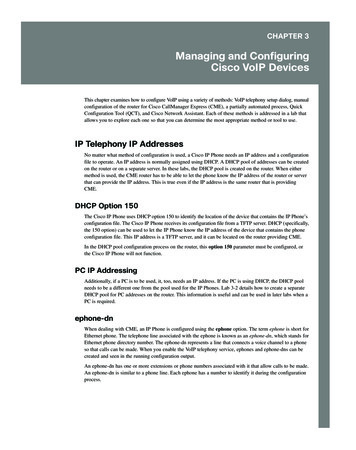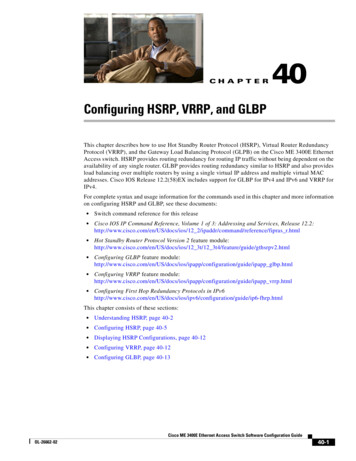
Transcription
CH A P T E R40Configuring HSRP, VRRP, and GLBPThis chapter describes how to use Hot Standby Router Protocol (HSRP), Virtual Router RedundancyProtocol (VRRP), and the Gateway Load Balancing Protocol (GLPB) on the Cisco ME 3400E EthernetAccess switch. HSRP provides routing redundancy for routing IP traffic without being dependent on theavailability of any single router. GLBP provides routing redundancy similar to HSRP and also providesload balancing over multiple routers by using a single virtual IP address and multiple virtual MACaddresses. Cisco IOS Release 12.2(58)EX includes support for GLBP for IPv4 and IPv6 and VRRP forIPv4.For complete syntax and usage information for the commands used in this chapter and more informationon configuring HSRP and GLBP, see these documents: Switch command reference for this release Cisco IOS IP Command Reference, Volume 1 of 3: Addressing and Services, Release 12.2:http://www.cisco.com/en/US/docs/ios/12 2/ipaddr/command/reference/fipras r.html Hot Standby Router Protocol Version 2 feature module:http://www.cisco.com/en/US/docs/ios/12 3t/12 3t4/feature/guide/gthsrpv2.html Configuring GLBP feature onfiguration/guide/ipapp glbp.html Configuring VRRP feature onfiguration/guide/ipapp vrrp.html Configuring First Hop Redundancy Protocols in guration/guide/ip6-fhrp.htmlThis chapter consists of these sections: Understanding HSRP, page 40-2 Configuring HSRP, page 40-5 Displaying HSRP Configurations, page 40-12 Configuring VRRP, page 40-12 Configuring GLBP, page 40-13Cisco ME 3400E Ethernet Access Switch Software Configuration GuideOL-26662-0240-1
Chapter 40Configuring HSRP, VRRP, and GLBPUnderstanding HSRPUnderstanding HSRPHSRP is the Cisco standard method of providing high network availability by providing first-hopredundancy for IP hosts on an IEEE 802 LAN configured with a default gateway IP address. HSRP routesIP traffic without relying on the availability of any single router. It enables a set of router interfaces towork together to present the appearance of a single virtual router or default gateway to the hosts on aLAN. When HSRP is configured on a network or segment, it provides a virtual Media Access Control(MAC) address and an IP address that is shared among a group of configured routers. HSRP allows twoor more HSRP-configured routers to use the MAC address and IP network address of a virtual router.The virtual router does not exist; it represents the common target for routers that are configured toprovide backup to each other. One of the routers is selected to be the active router and another to be thestandby router, which assumes control of the group MAC address and IP address should the designatedactive router fail.NoteRouters in an HSRP group can be any router interface that supports HSRP, including routed ports andswitch virtual interfaces (SVIs) on the switch.HSRP provides high network availability by providing redundancy for IP traffic from hosts on networks.In a group of router interfaces, the active router is the router of choice for routing packets; the standbyrouter is the router that takes over the routing duties when an active router fails or when preset conditionsare met.HSRP is useful for hosts that do not support a router discovery protocol and cannot switch to a new routerwhen their selected router reloads or loses power. When HSRP is configured on a network segment, itprovides a virtual MAC address and an IP address that is shared among router interfaces in a group ofrouter interfaces running HSRP. The router selected by the protocol to be the active router receives androutes packets destined for the group’s MAC address. For n routers running HSRP, there are n 1 IP andMAC addresses assigned.HSRP detects when the designated active router fails, and a selected standby router assumes control ofthe Hot Standby group’s MAC and IP addresses. A new standby router is also selected at that time.Devices running HSRP send and receive multicast UDP-based hello packets to detect router failure andto designate active and standby routers. When HSRP is configured on an interface, Internet ControlMessage Protocol (ICMP) redirect messages are automatically enabled for the interface.You can configure multiple Hot Standby groups among switches that are operating in Layer 3 to makemore use of the redundant routers. To do so, specify a group number for each Hot Standby commandgroup you configure for an interface. For example, you might configure an interface on switch 1 as anactive router and one on switch 2 as a standby router and also configure another interface on switch 2 asan active router with another interface on switch 1 as its standby router.Figure 40-1 shows a segment of a network configured for HSRP. Each router is configured with the MACaddress and IP network address of the virtual router. Instead of configuring hosts on the network withthe IP address of Router A, you configure them with the IP address of the virtual router as their defaultrouter. When Host C sends packets to Host B, it sends them to the MAC address of the virtual router. Iffor any reason, Router A stops transferring packets, Router B responds to the virtual IP address andvirtual MAC address and becomes the active router, assuming the active router duties. Host C continuesto use the IP address of the virtual router to address packets destined for Host B, which Router B nowreceives and sends to Host B. Until Router A resumes operation, HSRP allows Router B to provideuninterrupted service to users on Host C’s segment that need to communicate with users on Host B’ssegment and also continues to perform its normal function of handling packets between the Host Asegment and Host B.Cisco ME 3400E Ethernet Access Switch Software Configuration Guide40-2OL-26662-02
Chapter 40Configuring HSRP, VRRP, and GLBPUnderstanding HSRPFigure 40-1Typical HSRP ConfigurationHost r172.20.128.3172.20.128.2Router ARouter B172.20.128.55172.20.128.32Host CHost A101361ActiverouterHSRP VersionsThe switch supports these Hot Standby Router Protocol (HSRP) versions: HSRPv1—Version 1 of the HSRP, the default version of HSRP. It has these features:– The HSRP group number can be from 0 to 255.– HSRPv1 uses the multicast address 224.0.0.2 to send hello packets, which can conflict withCisco Group Management Protocol (CGMP) leave processing. You cannot enable HSRPv1 andCGMP at the same time; they are mutually exclusive. HSRPv2—Version 2 of the HSRP has these features:– To match the HSRP group number to the VLAN ID of a subinterface, HSRPv2 can use a groupnumber from 0 to 4095 and a MAC address from 0000.0C9F.F000 to 0000.0C9F.FFFF.– HSRPv2 uses the multicast address 224.0.0.102 to send hello packets. HSRPv2 and CGMPleave processing are no longer mutually exclusive, and both can be enabled at the same time.– HSRPv2 has a different packet format than HRSPv1.A switch running HSRPv1 cannot identify the physical router that sent a hello packet becausethe source MAC address of the router is the virtual MAC address.Cisco ME 3400E Ethernet Access Switch Software Configuration GuideOL-26662-0240-3
Chapter 40Configuring HSRP, VRRP, and GLBPUnderstanding HSRPHSRPv2 has a different packet format than HSRPv1. A HSRPv2 packet uses thetype-length-value (TLV) format and has a 6-byte identifier field with the MAC address of thephysical router that sent the packet.If an interface running HSRPv1 gets an HSRPv2 packet, the type field is ignored.HSRPv2 and HSRPv1 are mutually exclusive. HSRPv2 is not interoperable with HSRPv1 on an interfaceand the reverse.Multiple HSRPThe switch supports Multiple HSRP (MHSRP), an extension of HSRP that allows load sharing betweentwo or more HSRP groups. You can configure MHSRP to achieve load balancing and to use two or morestandby groups (and paths) from a host network to a server network. In Figure 40-2, half the clients areconfigured for Router A, and half the clients are configured for Router B. Together, the configuration forRouters A and B establishes two HSRP groups. For group 1, Router A is the default active router becauseit has the assigned highest priority, and Router B is the standby router. For group 2, Router B is thedefault active router because it has the assigned highest priority, and Router A is the standby router.During normal operation, the two routers share the IP traffic load. When either router becomesunavailable, the other router becomes active and assumes the packet-transfer functions of the router thatis unavailable.See the “Configuring MHSRP” section on page 40-10 for the example configuration steps.NoteFor MHSRP, you need to enter the standby preempt interface configuration command on the HSRPinterfaces so that if a router fails and then comes back up, preemption restores load sharing.Figure 40-2MHSRP Load SharingActive router for group 1Standby router for group 2Active router for group 2Standby router for group 1Router ARouter B10.0.0.212123510.0.0.1Client 1Client 2Client 3Client 4Cisco ME 3400E Ethernet Access Switch Software Configuration Guide40-4OL-26662-02
Chapter 40Configuring HSRP, VRRP, and GLBPConfiguring HSRPConfiguring HSRP Default HSRP Configuration, page 40-5 HSRP Configuration Guidelines, page 40-5 Enabling HSRP, page 40-6 Configuring HSRP Priority, page 40-7 Configuring MHSRP, page 40-10 Configuring HSRP Authentication and Timers, page 40-10 Enabling HSRP Support for ICMP Redirect Messages, page 40-12Default HSRP ConfigurationTable 40-1 shows the default HSRP configuration.Table 40-1Default HSRP ConfigurationFeatureDefault SettingHSRP versionVersion 1HSRP groupsNone configuredStandby group number0Standby MAC addressSystem assigned as: 0000.0c07.acXX, where XX is the HSRPgroup numberStandby priority100Standby delay0 (no delay)Standby track interface priority10Standby hello time3 secondsStandby holdtime10 secondsHSRP Configuration Guidelines HSRP can be configured on a maximum of 32 VLAN or routing interfaces. In the procedures, the specified interface must be one of these Layer 3 interfaces:– Routed port: a physical port configured as a Layer 3 port by entering the no switchportinterface configuration command.– SVI: a VLAN interface created by using the interface vlan vlan id global configurationcommand and by default a Layer 3 interface.– Etherchannel port channel in Layer 3 mode: a port-channel logical interface created by usingthe interface port-channel port-channel-number global configuration command and bindingthe Ethernet interface into the channel group. For more information, see the “ConfiguringLayer 3 EtherChannels” section on page 36-14. All Layer 3 interfaces must have IP addresses assigned to them. See the “Configuring Layer 3Interfaces” section on page 10-25.Cisco ME 3400E Ethernet Access Switch Software Configuration GuideOL-26662-0240-5
Chapter 40Configuring HSRP, VRRP, and GLBPConfiguring HSRP HSRPv2 and HSRPv1 can be configured on the same switch if HSRPv2 is configured on differentinterfaces than those on which HSRPv1 is configured. The version of an HSRP group can be changed from HSRPv2 to HSRPv1 only if the group numberis less than 256. If you change the HSRP version on an interface, each HSRP group resets because it now has a newvirtual MAC address.Enabling HSRPThe standby ip interface configuration command activates HSRP on the configured interface. If an IPaddress is specified, that address is used as the designated address for the Hot Standby group. If no IPaddress is specified, the address is learned through the standby function. You must configure at least oneLayer 3 port on the LAN with the designated address. Configuring an IP address always overridesanother designated address currently in use.When the standby ip command is enabled on an interface and proxy ARP is enabled, if the interface’sHot Standby state is active, proxy ARP requests are answered using the Hot Standby group MACaddress. If the interface is in a different state, proxy ARP responses are suppressed.Beginning in privileged EXEC mode, follow these steps to create or enable HSRP on a Layer 3 interface:CommandPurposeStep 1configure terminalEnter global configuration mode.Step 2interface interface-idEnter interface configuration mode, and enter the Layer 3 interface onwhich you want to enable HSRP.Step 3no shutdownEnable the port, if necessary. By default, user network interfaces (UNIs)and enhanced network interfaces (ENIs) are disabled, and network nodeinterfaces (NNIs) are enabled.Step 4no switchportIf necessary, disable Layer 2 switching on the port to enable the Layer 3interface.Step 5standby version {1 2}(Optional) Configure the HSRP version on the interface. 1— Select HSRPv1. 2— Select HSRPv2.If you do not enter this command or do not specify a keyword, theinterface runs the default HSRP version, HSRP v1.Cisco ME 3400E Ethernet Access Switch Software Configuration Guide40-6OL-26662-02
Chapter 40Configuring HSRP, VRRP, and GLBPConfiguring HSRPStep 6CommandPurposestandby [group-number] ip [ip-address[secondary]]Create (or enable) the HSRP group using its number and virtual IPaddress. (Optional) group-number—The group number on the interface forwhich HSRP is being enabled. The range is 0 to 255; the default is 0.If there is only one HSRP group, you do not need to enter a groupnumber. (Optional on all but one interface) ip-address—The virtual IP addressof the hot standby router interface. You must enter the virtual IPaddress for at least one of the interfaces; it can be learned on the otherinterfaces. (Optional) secondary—The IP address is a secondary hot standbyrouter interface. If neither router is designated as a secondary orstandby router and no priorities are set, the primary IP addresses arecompared and the higher IP address is the active router, with the nexthighest as the standby router.Step 7endReturn to privileged EXEC mode.Step 8show standby [interface-id [group]]Verify the configuration.Step 9copy running-config startup-config(Optional) Save your entries in the configuration file.Use the no standby [group-number] ip [ip-address] interface configuration command to disable HSRP.This example shows how to activate HSRP for group 1 on an interface. The IP address used by the hotstandby group is learned by using HSRP.NoteThis procedure is the minimum number of steps required to enable HSRP. Other configuration isoptional.Switch# configure terminalSwitch(config)# interface gigabitethernet0/1Switch(config-if)# no switchportSwitch(config-if)# standby 1 ipSwitch(config-if)# endSwitch# show standbyConfiguring HSRP PriorityThe standby priority, standby preempt, and standby track interface configuration commands are allused to set characteristics for finding active and standby routers and behavior regarding when a newactive router takes over.When configuring HSRP priority, follow these guidelines: Assigning a priority allows you to select the active and standby routers. If preemption is enabled,the router with the highest priority becomes the active router. If priorities are equal, the currentactive router does not change. The highest number (1 to 255) represents the highest priority (most likely to become the activerouter).Cisco ME 3400E Ethernet Access Switch Software Configuration GuideOL-26662-0240-7
Chapter 40Configuring HSRP, VRRP, and GLBPConfiguring HSRP When setting the priority, preempt, or both, you must specify at least one keyword (priority,preempt, or both). The priority of the device can change dynamically if an interface is configured with the standbytrack command and another interface on the router goes down. The standby track interface configuration command ties the router hot standby priority to theavailability of its interfaces and is useful for tracking interfaces that are not configured for HSRP.When a tracked interface fails, the hot standby priority on the device on which tracking has beenconfigured decreases by 10. If an interface is not tracked, its state changes do not affect the hotstandby priority of the configured device. For each interface configured for hot standby, you canconfigure a separate list of interfaces to be tracked. The standby track interface-priority interface configuration command specifies how much todecrement the hot standby priority when a tracked interface goes down. When the interface comesback up, the priority is incremented by the same amount. When multiple tracked interfaces are down and interface-priority values have been configured, theconfigured priority decrements are cumulative. If tracked interfaces that were not configured withpriority values fail, the default decrement is 10, and it is noncumulative. When routing is first enabled for the interface, it does not have a complete routing table. If it isconfigured to preempt, it becomes the active router, even though it is unable to provide adequaterouting services. To solve this problem, configure a delay time to allow the router to update itsrouting table.Beginning in privileged EXEC mode, use one or more of these steps to configure HSRP prioritycharacteristics on an interface:CommandPurposeStep 1configure terminalEnter global configuration mode.Step 2interface interface-idEnter interface configuration mode, and enter the HSRP interface on which youwant to set priority.Step 3no shutdownEnable the port, if necessary. By default, UNIs and ENIs are disabled, andNNIs are enabled.Step 4standby [group-number] priorityprioritySet a priority value used in choosing the active router. The range is 1 to 255;the default priority is 100. The highest number represents the highest priority. (Optional) group-number—The group number to which the commandapplies.Use the no form of the command to restore the default values.Cisco ME 3400E Ethernet Access Switch Software Configuration Guide40-8OL-26662-02
Chapter 40Configuring HSRP, VRRP, and GLBPConfiguring HSRPCommandStep 5Purposestandby [group-number] preempt Configure the router to preempt, which means that when the local router has[delay [minimum seconds] [reload a higher priority than the active router, it becomes the active router.seconds] [sync seconds]] (Optional) group-number—The group number to which the commandapplies. (Optional) delay minimum—Set to cause the local router to postponetaking over the active role for the number of seconds shown. The range is0 to 36000 seconds (1 hour); the default is 0 (no delay before taking over). (Optional) delay reload—Set to cause the local router to postpone takingover the active role after a reload for the number of seconds shown. Therange is 0 to 36000 seconds (1 hour); the default is 0 (no delay beforetaking over after a reload). (Optional) delay sync—Set to cause the local router to postpone takingover the active role so that IP redundancy clients can reply (either with anok or wait reply) for the number of seconds shown. The range is 0 to 36000seconds (1 hour); the default is 0 (no delay before taking over).Use the no form of the command to restore the default values.Step 6standby [group-number] tracktype number [interface-priority]Configure an interface to track other interfaces so that if one of the otherinterfaces goes down, the device’s Hot Standby priority is lowered. (Optional) group-number—The group number to which the commandapplies. type—Enter the interface type (combined with interface number) that istracked. number—Enter the interface number (combined with interface type) that istracked. (Optional) interface-priority—Enter the amount by which the hot standbypriority for the router is decremented or incremented when the interfacegoes down or comes back up. The default value is 10.Step 7endReturn to privileged EXEC mode.Step 8show running-configVerify the configuration of the standby groups.Step 9copy running-configstartup-config(Optional) Save your entries i
GLBP provides routing redundancy similar to HSRP and also provides load balancing over multiple routers by using a single virtual IP address and multiple virtual MAC addresses. Cisco IOS Release 12.2(58)EX inclu
